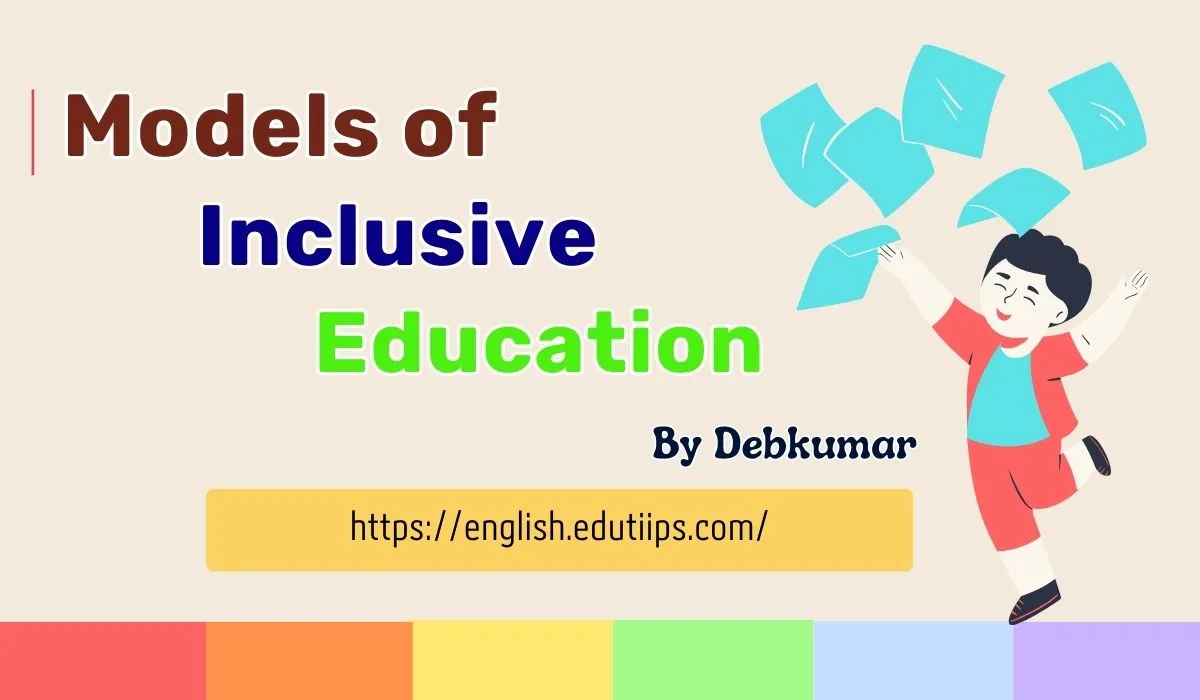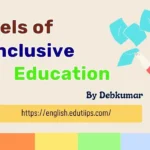Discover the different models of inclusion in education, including full and partial inclusion, with practical examples and benefits for diverse learners.
Inclusive education is a globally evolving concept that ensures all children, regardless of their physical, mental, or social differences, learn together in the same environment. Inclusion promotes equity, diversity, and access to quality education for every student, including those with disabilities or special needs. However, achieving true inclusion requires specific strategies and frameworks—these are called models of inclusion.
In this article, we will explore the key models used in inclusive education, their characteristics, benefits, and how different countries implement them.
What Are Models of Inclusion in Education?
A model of inclusion refers to a structured approach or framework used by schools to integrate students with diverse learning needs into general classrooms. These models help educators provide customized support, maintain curriculum standards, and ensure equal participation for all students. Different models serve different purposes depending on available resources, teacher readiness, and the type of disability being addressed.
Major Models of Inclusive Education
Here are some of the Major Models of Inclusive Education or Models of Inclusion in Education discussed –
a) Full Inclusion Model
In the full inclusion model, all students—regardless of their abilities—attend the same general education classroom for the entire school day. This approach eliminates the need for separate special education classes. Special education teachers may work alongside general teachers to provide support through co-teaching and Individualized Education Plans (IEPs).
According to Friend & Bursuck (2002) – “Full inclusion means that all students, regardless of the severity of their disability, receive their entire education in the general education classroom.”
Benefits –
The important benefits or advantages of the full inclusion model are –
- Promotes social interaction and reduces stigma
- Encourages peer learning and empathy
- Social Skill Development
- Unified Learning Environment
- Equity & Inclusion.
- Reduced Labeling
Challenges –
The important challenges or disadvantages of the full inclusion model are –
- Requires well-trained teachers and support staff.
- Needs adaptive curriculum and technology.
- Lack of Teacher Training.
- Emotional Strain.
- Resource Constraints.
b) Partial Inclusion Model
Partial inclusion allows students with disabilities to spend part of the school day in the general classroom and the rest in special education settings. This flexible model adapts to the learner’s strengths and areas needing support.
According to Gargiulo & Metcalf (2017) – “Partial inclusion refers to students with disabilities spending a portion of the day in general education classrooms, while receiving specialized services in separate settings for the rest of the day.”
According to Smith & Tyler (2010) – “Partial inclusion is a model in which students with disabilities spend part of their day in the general education classroom and part in a special education setting, based on their individual needs.”
Benefits –
The important benefits or advantages of the partial inclusion model are –
- Offers specialized help without full separation.
- Suitable for students with moderate to severe needs.
- Personalized Learning.
- Step Toward Full Inclusion.
- Easier for General Teachers.
- Individualized Support.
- Reduced Academic Pressure.
- Flexible Learning Environment.
- Balanced Social Interaction.
Challenges –
The important challenges or disadvantages of the partial inclusion model are –
- Scheduling and coordination between staff can be complex.
- Coordination Challenges.
- Limited Exposure to General Curriculum.
- Fragmented Experience.
The Partial Inclusion Model offers a practical balance between full inclusion and separate special education. It recognizes the diverse needs of students and attempts to serve them through flexible, targeted instruction.
c) Mainstreaming in Education
Mainstreaming is the selective placement of special education students in one or more regular education classes.
Mainstreaming involves placing students with disabilities in regular classrooms only when they meet specific academic or behavioral standards. It’s based on the idea of readiness—students are expected to adapt to the regular setting rather than modify the system.
According to Hallahan, Kauffman & Pullen (2012) – “Mainstreaming is the practice of placing students with special needs into general education classrooms for at least part of their school day, depending on their abilities and needs.”
Benefits –
The important benefits or advantages of the Mainstreaming in Education are –
- Encourages skill development and goal setting
- Often used for students with mild disabilities
- Improved Academic Motivation.
- Preparation for Real World.
- Efficient Use of Resources.
Challenges –
The important challenges or disadvantages of the Mainstreaming in Education are –
- Can feel exclusive for students who do not meet entry criteria.
- Reduced Individual Attention.
- Lack of Individual Support.
- Limited Time in General Classrooms.
- Disruptions in Learning.
Mainstreaming is a balanced approach between special education and full inclusion. While it offers social and academic benefits, it demands careful planning, teacher training, and ongoing support to be truly effective.
d) Reverse Inclusion or Special School Collaboration
In this model, either students with disabilities are occasionally integrated into mainstream activities, or general students visit special education settings for interaction and group learning. Though not a full inclusion strategy, it serves as a bridge to promote understanding and inclusion.
According to Carter & Hughes (2007) – “Reverse inclusion involves integrating non-disabled peers into settings designed primarily for students with disabilities to promote social interaction, mutual understanding, and inclusive practices.”
Benefits –
The important benefits or advantages of the Reverse Inclusion model are –
- Promotes Social Interaction.
- Comfortable Learning for Students with Disabilities.
- Fosters Empathy and Acceptance.
- Peer Modeling Opportunities.
- Customized Pacing and Support.
Challenges –
The important challenges or disadvantages of the Reverse Inclusion model are –
- Limited Academic Challenge for Non-disabled Peers.
- Resource and Staffing Requirements.
- Not a Substitute for Full Inclusion.
- Possible Social Imbalance.
Models of Inclusive Education Comparison Chart
Here are some of the Major Models of Inclusive Education or Models of Inclusion in Education Comparison Chart discussed –
| Model | Inclusion Time | Support Level | Key Advantage | Common Challenge |
| Full Inclusion | 100% | High (co-teaching) | Equal access | Requires training |
| Partial Inclusion | 40–80% | Moderate | Flexibility | Coordination issues |
| Mainstreaming in Education | Conditional | Minimal | Skill-based entry | Not truly inclusive |
| Reverse Inclusion | Occasional | Variable | Social exposure | Limited impact |
Global Examples of Inclusion Models or Models of Inclusion in Education
Here are some of the Global Examples of Inclusion Models or Models of Inclusion in Educationdiscussed –
India: Practices partial inclusion under Sarva Shiksha Abhiyan (SSA), with support through resource centers.
USA: Under the Individuals with Disabilities Education Act (IDEA), full inclusion and IEP-based teaching are widely practiced.
Canada: Inclusive education is guided by Universal Design for Learning (UDL) principles, ensuring curriculum accessibility.
Finland: Uses a full inclusion approach with differentiated instruction as the norm.
Benefits of Using Inclusive Models or Models of Inclusion in Education
Here are some of the Benefits of Using Inclusive Models discussed –
i) Encourages empathy and peer bonding
ii) Promotes academic equity
iii) Builds a democratic and just school culture
iv) Prepares all students for real-world diversity
Challenges & Ethical Concerns of Models of Inclusion in Education
Here are some of the challenges and ethical concerns discussed –
i) Limited infrastructure and assistive tools,
ii) Teachers may lack training in inclusive strategies
iii) Parents may resist full inclusion due to fear or lack of awareness
iv) Ethical concerns when inclusion becomes tokenistic or superficial
Conclusion of Models of Inclusion in Education
Inclusive education is more than just placing students in the same room. It is about creating a system that respects differences, adapts teaching for all learners, and builds a learning environment where everyone thrives. Understanding and applying the right model of inclusion is a crucial step toward making this vision a reality. – Based on my experience as an education teacher.
References
- Mangal, S. K. (2020). Inclusive education: Strategies and practices (2nd ed.). PHI Learning.
- Smith, J. A., & Brown, L. M. (2020). Inclusive education: Principles and practices (3rd ed.). Educational Press.
- Kumar, S., & Patel, N. (2021). Understanding diverse learners: Inclusive education approaches. Global Education Publishers.
- Thompson, G. (2017). Teaching students with special needs: Inclusive practices (4th ed.). Learning Tree Press.
- Models of Inclusion in Education
Q – What are the different models of inclusion in education?
Ans – The common models of inclusion include the Full Inclusion Model, Partial Inclusion Model, Mainstreaming, and Segregated Model. These models vary in the degree to which students with disabilities learn alongside their non-disabled peers.
Q – How do inclusive education models benefit diverse learners?
Ans – Inclusive education models promote social integration, improve academic outcomes, and foster acceptance and respect among all students by providing tailored support and removing barriers to learning.
Q. – How can schools effectively implement models of inclusion?
Ans – Schools can implement inclusion effectively by providing adequate training, fostering teamwork among teachers, involving families, adapting curriculum, and ensuring access to necessary assistive technologies.
Q – What challenges do educators face when implementing inclusion models?
Ans – Implementing inclusion models challenges include lack of resources, insufficient teacher training, large class sizes, and resistance to change in school culture etc.




